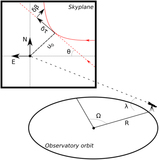Measuring the Microlensing Parallax from Various Space Observatories
Abstract
A few observational methods allow the measurement of the mass and distance of the lens-star for a microlensing event. A first estimate can be obtained by measuring the microlensing parallax effect produced by either the motion of the Earth (annual parallax) or the contemporaneous observation of the lensing event from two (or more) observatories (space or terrestrial parallax) sufficiently separated from each other. Further developing ideas originally outlined by Gould as well as Mogavero & Beaulieu, we review the possibility of measuring systematically the microlensing parallax using a telescope based on the Moon surface and other space-based observing platforms, including the upcoming WFIRST space-telescope. We first generalize the Fisher matrix formulation and present results demonstrating the advantage for each observing scenario. We conclude by outlining the limitation of the Fisher matrix analysis when submitted to a practical data modeling process. By considering a lunar-based parallax observation, we find that parameter correlations introduce a significant loss in detection efficiency of the probed lunar parallax effect.
- Publication:
-
The Astronomical Journal
- Pub Date:
- May 2018
- DOI:
- 10.3847/1538-3881/aab3c8
- arXiv:
- arXiv:1803.00689
- Bibcode:
- 2018AJ....155..191B
- Keywords:
-
- gravitational lensing: micro;
- parallaxes;
- Astrophysics - Earth and Planetary Astrophysics
- E-Print:
- AJ accepted
